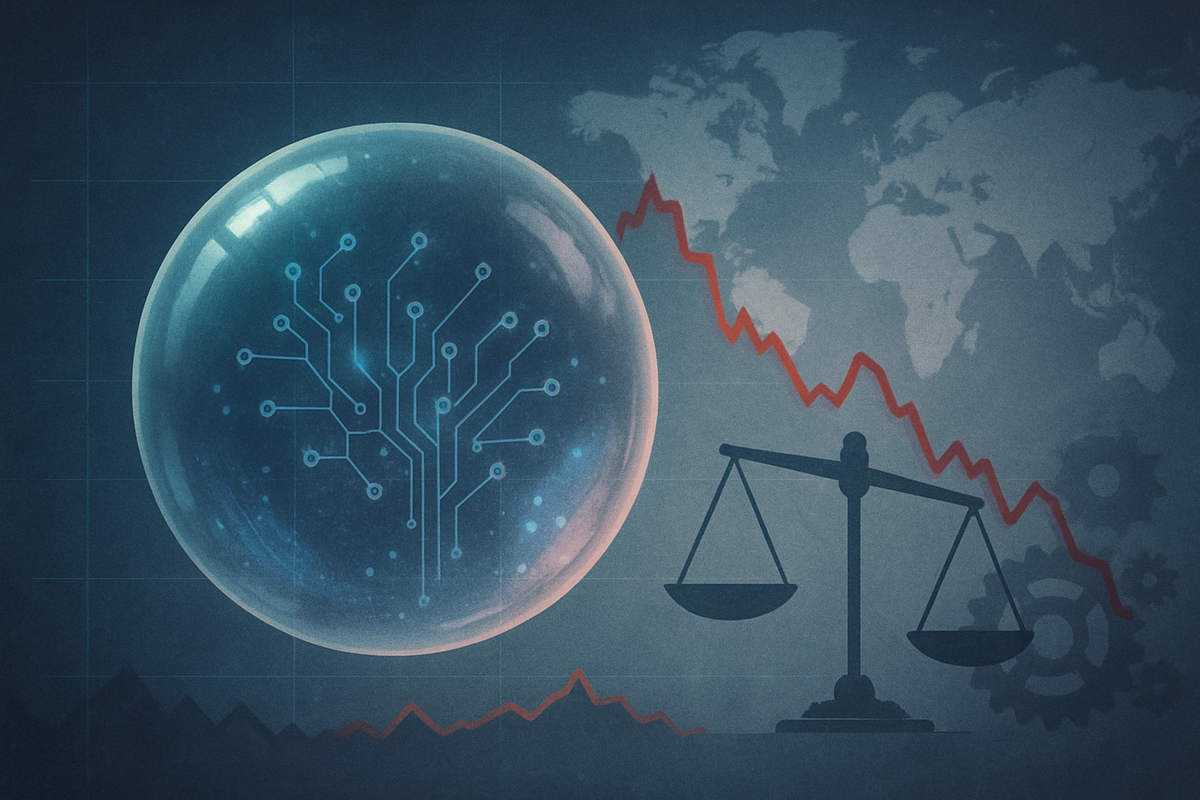
The global technology sector finds itself at a critical juncture in October 2025, grappling with escalating fears of an "AI bubble" as the Nasdaq Composite retreats from its recent record-setting highs. This recalibration is sending ripples across financial markets worldwide, prompting investors and companies to reassess the sustainability of the AI-driven rally and its profound implications, particularly for tech hubs in Asia and Europe. The current environment echoes past speculative frenzies, with concerns over stretched valuations and a potential market correction dominating financial discourse.
The immediate implications are a palpable shift towards caution and a potential rotation of capital away from high-growth technology stocks. With a significant portion of market wealth concentrated in a few AI-heavy "Magnificent 7" companies, the risk of systemic fragility is pronounced. This scenario demands a careful re-evaluation of investment strategies, emphasizing profitability and financial resilience over unchecked growth, as global markets brace for what could be a significant reordering of the tech landscape.
The AI Euphoria and Nasdaq's Recent Volatility
The lead-up to October 2025 saw an unprecedented surge in technology stocks, fueled by fervent optimism surrounding Artificial Intelligence advancements and expectations of Federal Reserve interest rate cuts. On October 8, 2025, the Nasdaq 100 (NDX) achieved a new all-time closing high of 25,137, while the Nasdaq Composite (IXIC) soared to an all-time closing high of 23,043.38. This momentum continued into October 9, 2025, with the Nasdaq Composite hitting an intraday peak of 23,062.62. Deals such as Advanced Micro Devices' (NASDAQ: AMD) partnership with OpenAI further ignited investor enthusiasm, propelling significant stock jumps across the sector.
However, this dizzying ascent was met with an abrupt recalibration. Around October 8-9, 2025, the Nasdaq Composite experienced a notable stumble from these record highs, signaling a shift in market sentiment. On October 9, 2025, the S&P 500 (SPX) fell 0.3%, and the Nasdaq Composite dropped approximately 0.3% after its intraday peak. This downturn can be attributed to several converging factors: cooling expectations for aggressive Federal Reserve interest rate cuts, mounting concerns over potentially inflated valuations within the AI sector, and the lingering uncertainty caused by an ongoing U.S. government shutdown, which delayed the release of crucial economic data.
Warnings from influential financial bodies have amplified these concerns. In October 2025, both the Bank of England and the International Monetary Fund (IMF) explicitly cautioned about the increasing risk of a sharp market correction. The Bank of England highlighted that equity market valuations, particularly for AI companies, appeared stretched, leaving markets vulnerable if AI expectations proved overly optimistic. Research from the Massachusetts Institute of Technology, indicating that 95% of organizations have seen zero return on their generative AI investments, further fueled doubts about the technology's immediate economic promise, contributing to the profit-taking and the shift in investor focus from "growth at all costs" to profitability and cash flow.
The concentration of market wealth in a few "Magnificent 7" tech companies, all heavily invested in AI, presents a significant concentration risk. These include giants like Apple (NASDAQ: AAPL), Microsoft (NASDAQ: MSFT), Alphabet (NASDAQ: GOOGL), Amazon (NASDAQ: AMZN), Nvidia (NASDAQ: NVDA), Meta Platforms (NASDAQ: META), and Tesla (NASDAQ: TSLA). The sheer size and influence of these companies mean that any significant deflation of the AI bubble could have profound ripple effects, impacting not only the tech sector but also venture capital funding, related industries, and potentially the broader global economy, including Asia and Europe.
Companies Navigating the AI Recalibration: Potential Winners and Losers
The current recalibration of the technology sector, driven by 'AI bubble fears,' is creating a distinct divide between potential winners and losers, particularly impacting companies in Asia and Europe. Those with sustainable AI revenue models, strong fundamentals, and diversified portfolios are better positioned to weather the storm, while overvalued AI pure-plays and those heavily reliant on speculative funding face significant headwinds.
Potential Winners: Companies that can demonstrate clear, profitable applications of AI, rather than just hype, are likely to emerge stronger. Established tech giants with robust balance sheets and diverse revenue streams, such as Microsoft (NASDAQ: MSFT) and Alphabet (NASDAQ: GOOGL), which are integrating AI into existing, revenue-generating products, stand to benefit. Their ability to invest in long-term AI research and development without immediate pressure for speculative returns provides a significant advantage. In Asia, semiconductor manufacturers like Samsung Electronics (KRX: 005930) and SK Hynix (KRX: 000660) are crucial players in the AI supply chain. Despite broader market fears, demand for AI-enabling chips remains strong, driving these companies to record highs and positioning them as key beneficiaries, provided the fundamental demand for AI hardware persists. Companies focused on AI infrastructure, cybersecurity for AI, or specialized enterprise AI solutions that solve tangible business problems are also likely to thrive by demonstrating concrete ROI.
Potential Losers: On the other hand, companies with exorbitant valuations based solely on future AI potential, or those with unclear paths to profitability, are most vulnerable. Many smaller, privately held AI startups that have relied heavily on venture capital funding may find it increasingly difficult to secure new investment rounds as investors become more risk-averse. Publicly traded "AI pure-plays" that lack substantial revenue or are operating at significant losses, despite high market capitalization, could see sharp corrections. Companies involved in "circular deals" – such as OpenAI, Nvidia (NASDAQ: NVDA), Advanced Micro Devices (NASDAQ: AMD), and Oracle (NYSE: ORCL) – are under scrutiny. While these collaborations can be strategic, concerns about their sustainability and genuine profitability, especially for companies like OpenAI projected to not be cash-flow positive until 2030 despite a US$500 billion valuation, could lead to investor skepticism and valuation adjustments. European tech companies that have seen their valuations inflated by general AI enthusiasm but lack strong underlying fundamentals or clear AI monetization strategies could also face significant downward pressure.
The shift in investor focus from "growth at all costs" to profitability, cash flow, and financial resilience means that companies with sustainable business models and a clear path to generating returns from their AI investments will be favored. Those that have ridden the wave of speculative AI enthusiasm without solidifying their financial foundations are now facing a harsh reality, potentially leading to significant stock price declines, reduced access to capital, and increased pressure to demonstrate tangible value.
Wider Significance: A Global Tech Paradigm Shift
The 'AI bubble fears' and subsequent recalibration of the technology sector signify more than just a market correction; they represent a potential paradigm shift with far-reaching implications for global industry trends, regulatory frameworks, and geopolitical dynamics. This event fits into a broader narrative of market maturity for emerging technologies, where initial euphoria gives way to a more sober assessment of value and sustainability.
Historically, the tech sector has experienced cycles of boom and bust, with the dot-com bubble of the late 1990s serving as a prominent precedent. Similar to that era, current AI valuations are being scrutinized for being "stretched," with tech stocks now constituting approximately 40% of the S&P 500 (SPX), a concentration level not seen in 50 years. This time, however, the stakes are arguably higher due to AI's pervasive potential across all industries. The current recalibration could lead to a healthier, more sustainable growth trajectory for AI, as companies are compelled to demonstrate concrete returns on investment rather than relying on speculative fervor. This aligns with broader industry trends emphasizing responsible AI development, ethical considerations, and real-world application over theoretical capabilities.
The ripple effects extend across the entire tech ecosystem. Competitors will face increased pressure to differentiate their AI offerings with tangible results, rather than mere promises. Partners in the supply chain, particularly in the semiconductor industry, which has seen immense gains from AI demand, may experience volatility if the demand outlook softens or if major AI players scale back ambitious projects. For instance, while companies like SK Hynix (KRX: 000660) and Samsung Electronics (KRX: 005930) in Asia have benefited from surging chip demand, a significant downturn in AI investment could impact their future growth. Moreover, the concentration risk posed by the "Magnificent 7" tech companies means that any substantial market correction could have systemic implications, impacting venture capital funding for smaller AI startups globally.
Regulatory and policy implications are also coming to the forefront. The warnings from the Bank of England and the IMF in October 2025 highlight concerns about financial stability and the need for oversight in rapidly expanding tech markets. Policymakers in Asia and Europe, already grappling with regulating AI's ethical and societal impacts, may now also focus on market stability and preventing excessive speculation. This could lead to increased scrutiny of AI investment practices, data governance, and antitrust concerns, particularly in regions like the European Union which has been proactive in tech regulation. The US government shutdown, while seemingly unrelated, adds another layer of uncertainty, delaying crucial economic data that could inform policy decisions and market sentiment. This global recalibration underscores the need for a coordinated international approach to manage the risks and harness the benefits of AI responsibly.
What Comes Next: Navigating the New Tech Landscape
The recalibration triggered by 'AI bubble fears' ushers in a new phase for the technology sector, demanding strategic pivots and adaptive measures from companies and investors alike. In the short term, market volatility is likely to persist as investors digest earnings reports, assess the true profitability of AI initiatives, and monitor macroeconomic indicators. Companies that can quickly demonstrate a clear return on investment from their AI projects, rather than just showcasing technological prowess, will gain a significant advantage. This could lead to a consolidation phase, where well-capitalized firms acquire smaller, innovative AI startups with promising technologies but limited financial runway.
In the long term, the sector is poised for more sustainable growth, albeit at a potentially slower pace than the recent frenetic surge. This period will likely foster a greater emphasis on fundamental value, cash flow generation, and disciplined capital allocation. Tech companies will need to refine their AI strategies, focusing on applications that solve real-world problems and deliver measurable economic benefits. This might involve a shift from broad, speculative AI investments to targeted applications in areas like healthcare, energy efficiency, and advanced manufacturing, where AI can drive tangible productivity gains and cost reductions. For investors, this environment presents both challenges and opportunities. The challenge lies in distinguishing between genuine innovation and speculative hype, while the opportunity exists in identifying undervalued assets with strong underlying technology and a clear path to profitability.
Potential strategic pivots include a renewed focus on enterprise AI solutions, where the value proposition is often clearer and the customer base more stable. Companies might also prioritize mergers and acquisitions that bring in proven AI talent and intellectual property, rather than simply investing in internal R&D with uncertain outcomes. Market opportunities may emerge in niche AI applications, specialized hardware for AI inference at the edge, and robust cybersecurity solutions tailored for AI systems. Conversely, challenges will include securing funding for nascent AI projects, managing investor expectations in a less forgiving market, and navigating evolving regulatory landscapes, particularly in Europe and Asia where data privacy and AI ethics are paramount.
Potential scenarios range from a soft landing, where the market gradually corrects and then resumes a more sustainable growth trajectory, to a more pronounced downturn if confidence erodes significantly. A key determinant will be the upcoming third-quarter corporate earnings season, which will provide crucial insights into the actual financial performance of AI-driven companies. Clarity on AI monetization pathways, beyond speculative projections, will be vital in shaping market sentiment. Companies demonstrating strong unit economics, efficient scaling, and defensible competitive advantages in their AI offerings are most likely to thrive in this evolving landscape, setting the stage for a more mature and resilient technology sector in the years to come.
Wrap-Up: A New Era of Prudent AI Investment
The recent 'AI bubble fears' and the subsequent recalibration of the Nasdaq signify a pivotal moment for the global technology sector. The era of unbridled optimism and speculative investment in AI, while delivering remarkable innovations, is giving way to a more pragmatic and discerning market. The key takeaway is a renewed emphasis on fundamental value: profitability, robust cash flow, and a clear return on investment, rather than solely relying on future growth projections. This shift, underscored by warnings from major financial institutions and the Nasdaq's stumble from record highs, suggests a healthier, albeit more challenging, environment for tech companies and investors moving forward.
Moving ahead, the market will likely differentiate between genuine AI innovators with sustainable business models and those whose valuations were inflated by hype. This recalibration is not necessarily a negative event; it can prune overextended valuations and redirect capital towards more productive and impactful AI applications. For Asia and Europe, this means a dual focus: leveraging their strengths in semiconductor manufacturing and AI research, while also ensuring that domestic tech companies develop robust monetization strategies and adhere to prudent financial management. The resilience of markets like Japan's Nikkei 225 (NKY) and South Korea's Kospi Index (KOSPI), driven by strong demand for AI chips, highlights the continued underlying strength in certain segments, even amidst broader concerns.
Investors should watch closely for the upcoming corporate earnings reports, paying particular attention to how companies are articulating their AI strategies and, more importantly, demonstrating tangible financial results. Metrics such as customer acquisition costs, revenue per AI-driven product, and operational efficiencies gained through AI will become paramount. Furthermore, monitoring regulatory developments in AI governance across different regions will be crucial, as policy frameworks will increasingly shape the competitive landscape. The long-term impact of this recalibration will likely be a more mature and resilient tech sector, where sustainable innovation and disciplined financial performance are rewarded, fostering an environment where AI's transformative potential can be realized on a solid economic foundation.
This content is intended for informational purposes only and is not financial advice







